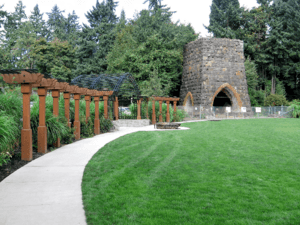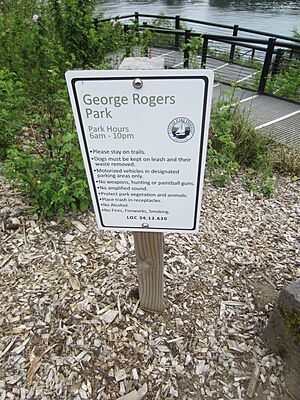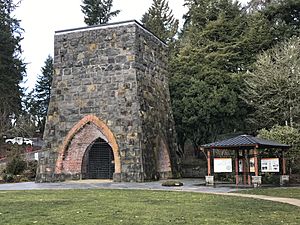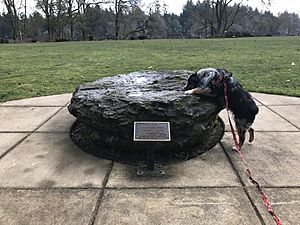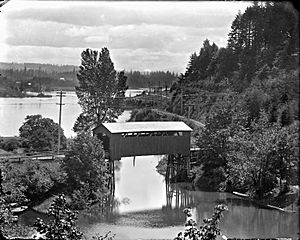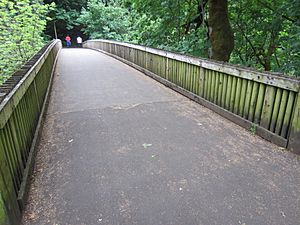George Rogers Park facts for kids
George Rogers Park is a big public park in Lake Oswego, Oregon. It's about 26 acres, which is like 20 football fields! You can find it where Ladd and South State streets meet.
This park has lots of cool stuff to do. There are two baseball fields and a soccer field for sports. You can also get to the Willamette River from here. Plus, there's a special memorial garden, restrooms, a playground, and two outdoor tennis courts. The park is also home to the historic Oregon Iron Company Furnace. This furnace is so important that it's listed on the National Register of Historic Places. The park is named after George Rogers, a City Councilman. He worked hard to make the park what it is today!
Contents
Park History: A Look Back in Time
George Rogers Park is Lake Oswego's very first community park. It's also one of its most interesting places. The park sits right on the Willamette River. This spot was important to Native American people over 10,000 years ago.
In the early 1800s, the river landing here was a handy camping place. Explorers, fur traders, and pioneers used it. It was like a rest stop for boats traveling up and down the river.
In 1850, Albert Alonzo Durham and his wife Miranda claimed 640 acres of land. This land included the river landing and Oswego Creek. Durham built a sawmill on the creek. He shipped lumber to places like San Francisco and Hawaii. He also started a town on the bluff above the river. He named it after Oswego, New York.
The same things that attracted Durham made it perfect for an iron furnace. The lake provided water power. The river landing made it easy to ship things. This landing was the town's main transportation spot for a long time. For 60 years, the beach was like an unofficial park. People would launch boats, fish, swim, and have picnics there.
In 1945, the City bought the land to make it a real park. In 1952, they named it after George Rogers.
The Oregon Iron Company: Making History
Building the Iron Company (1865–1877)
The Oregon Iron Company started in 1865. It was created by a group of important business people from Portland. They invested in shipping, railroads, and banks. Their goal was to make Portland a big center for business in Oregon. They wanted to control how iron was made in the Pacific Northwest.
The first leaders of the company were William Sargent Ladd, Hermon C. Leonard, and John Green.
The Famous Furnace
Ladd, Leonard, and Green hired George D. Wilbur. He was an expert at building furnaces from Connecticut. He designed the furnace to look like others from his home state. It had cool features like gothic arches and stone blocks.
Construction began in 1865 and finished 10 months later. The furnace started working on August 24, 1867. Everyone hoped Oswego would become the "Pittsburg of the West." Newspapers across the West celebrated it as a huge project. They said it would bring lots of wealth to Oregon.
The Oswego Iron Furnace was the first of its kind on the Pacific Coast. It's also the only one still standing west of the Rocky Mountains!
Changes and Challenges (1877–1894)
In 1877, the Oregon Iron Company was sold. It went to Samuel H. Brown, Jr. and Ernest W. Crichton. They knew a lot about making iron. They had worked for the company before. They started the Oswego Iron Company in 1878 and made many improvements.
But they also faced money problems. They sold the company to Simeon Gannett Reed and Henry Villard. Reed borrowed a lot of money to build a new, modern furnace. It opened in 1888, about half a mile north of the old one. This new factory also had the first pipe foundry west of St. Louis.
The company seemed ready to grow even more. However, a big economic crisis hit in 1893. This, along with arguments among owners and high costs, hurt the company badly. The furnace closed in 1894 and never opened again.
What's Left Today
You can still see a huge piece of solidified iron at the park's entrance. It weighs 13,000 pounds! This giant hunk of iron is called a "Salamander." It formed at the bottom of the iron furnace. These "Salamanders" had to be removed because they could block the furnace.
How Oregon Iron Grew and Fell
<graph>{ "version": 2, "width": 453, "height": 250, "data": [ { "name": "table", "values": [ { "x": 67, "y": 500 }, { "x": 68, "y": 700 }, { "x": 69, "y": 1000 }, { "x": 70, "y": 0 }, { "x": 71, "y": 0 }, { "x": 72, "y": 0 }, { "x": 73, "y": 0 }, { "x": 74, "y": 2500 }, { "x": 75, "y": 1050 }, { "x": 76, "y": 1800 }, { "x": 77, "y": 0 }, { "x": 78, "y": 1200 }, { "x": 79, "y": 2400 }, { "x": 80, "y": 5000 }, { "x": 81, "y": 6050 }, { "x": 82, "y": 6800 }, { "x": 83, "y": 7050 }, { "x": 84, "y": 3600 }, { "x": 85, "y": 3800 }, { "x": 86, "y": 0 }, { "x": 87, "y": 0 }, { "x": 88, "y": 2500 }, { "x": 89, "y": 9300 }, { "x": 90, "y": 12200 }, { "x": 91, "y": 10500 }, { "x": 92, "y": 8500 }, { "x": 93, "y": 5200 }, { "x": 94, "y": 1000 } ] } ], "scales": [ { "name": "x", "type": "ordinal", "range": "width", "zero": false, "domain": { "data": "table", "field": "x" } }, { "name": "y", "type": "linear", "range": "height", "nice": true, "domain": { "data": "table", "field": "y" } } ], "axes": [ { "type": "x", "scale": "x" }, { "type": "y", "scale": "y" } ], "marks": [ { "type": "rect", "from": { "data": "table" }, "properties": { "enter": { "x": { "scale": "x", "field": "x" }, "y": { "scale": "y", "field": "y" }, "y2": { "scale": "y", "value": 0 }, "fill": { "value": "steelblue" }, "width": { "scale": "x", "band": "true", "offset": -1 } } } } ] }</graph> This graph shows how much pig iron the Oregon Furnace made each year. The numbers are in tons. In 1874, the furnace had to close down. This was due to disagreements over water rights. Once these rights were settled, production started again.
The company faced tough times from 1874 to 1876 because of an economic depression. They didn't produce any iron in 1877. That's the year the company was sold to Brown and Crichton. The company made a record amount of iron in 1888. This was when Simeon Reed was in charge. But a financial crisis in 1893, along with other problems, forced the furnace to close for good in 1894.
Oswego Creek Bridges: Connecting the Community
The lower Oswego Creek Bridge is built at the mouth of Oswego Creek. This spot is right next to Oswego Landing. Over the past 150 years, four different bridges have been built here. The first bridges helped travelers get to Old River Road. This road ran along the west side of the Willamette River.
In the 1860s, a simple beam bridge was built. It was used by people walking, riding horses, and buggies. In 1885, a strong Howe truss bridge was built next to the older one. This new bridge helped the growing town and its iron industry.
By 1911, the truss bridge had a roof and walls. This protected it from the weather. It was used until a new concrete bridge was finished in 1920. People who hauled charcoal would use the covered bridge. They would follow a trail along the river.
After the new bridge, the covered bridge was only used by people on foot. It eventually rotted and fell apart in the 1930s. After World War II, a new bridge was built. But it became unsafe in 1975. The National Guard then removed it.


